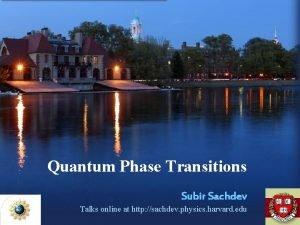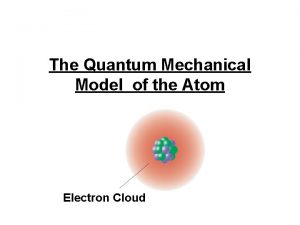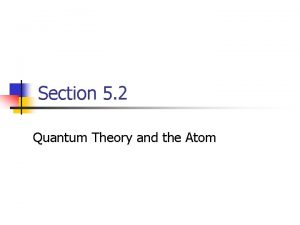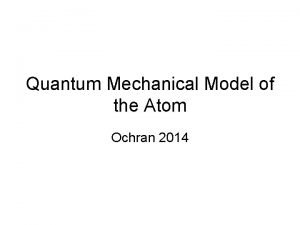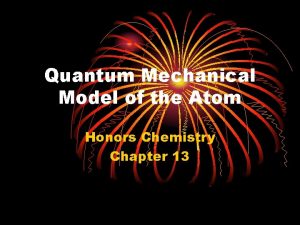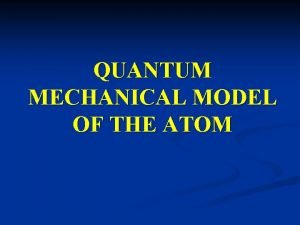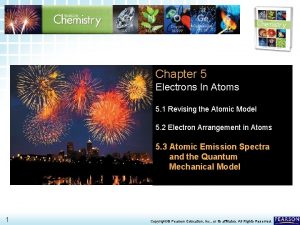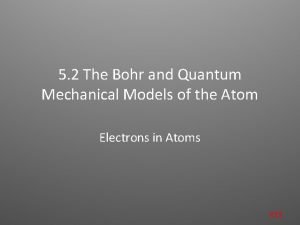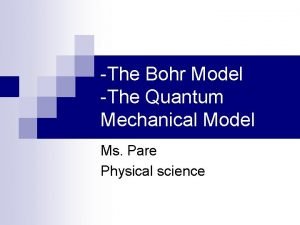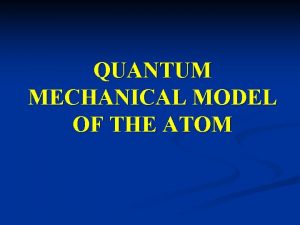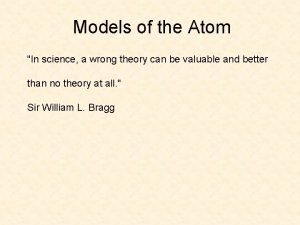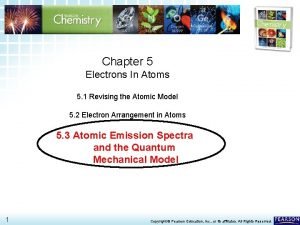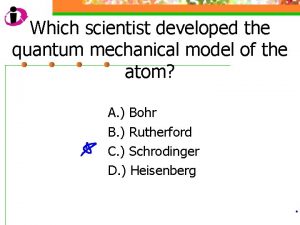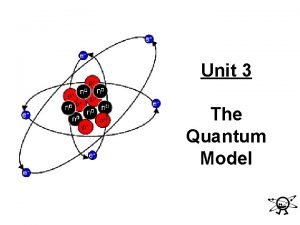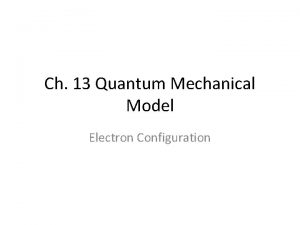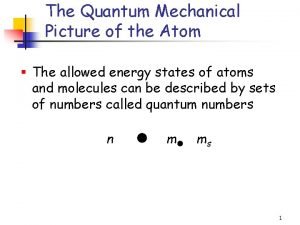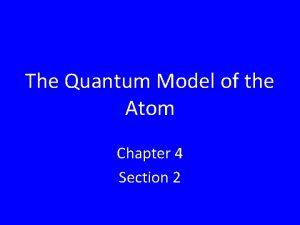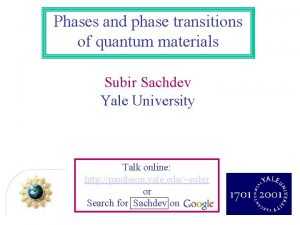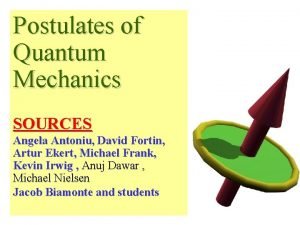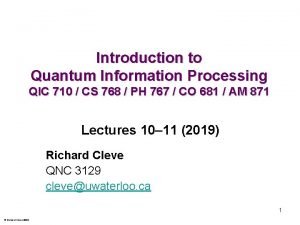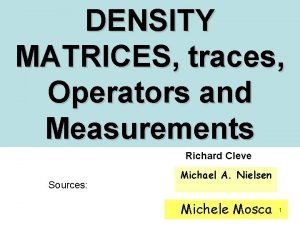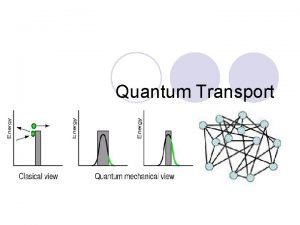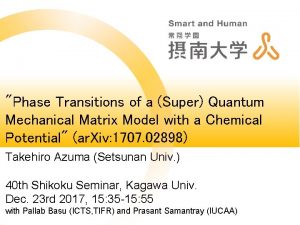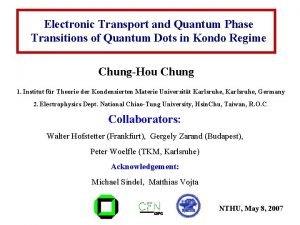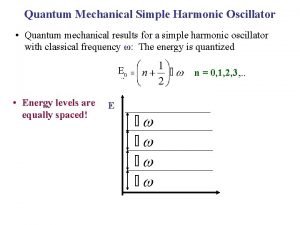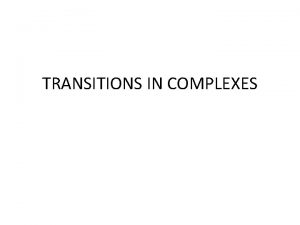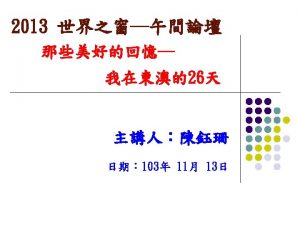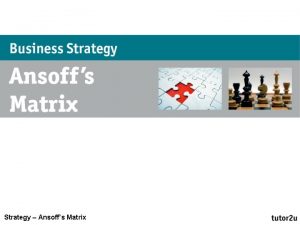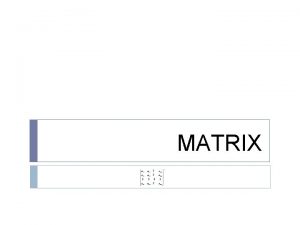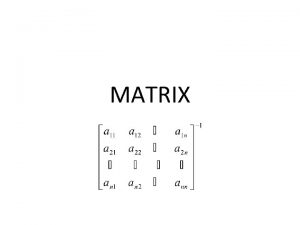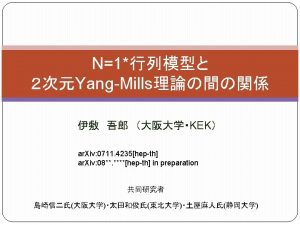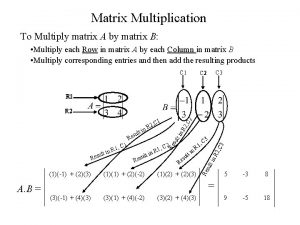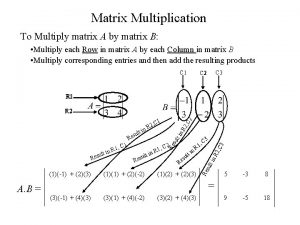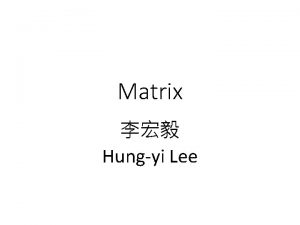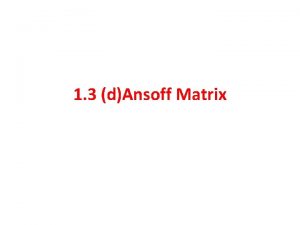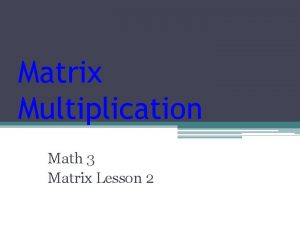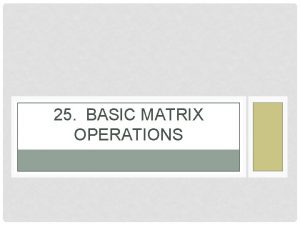Phase Transitions of a Super Quantum Mechanical Matrix



























- Slides: 27

"Phase Transitions of a (Super) Quantum Mechanical Matrix Model with a Chemical Potential in terms of partial deconfinement" (ar. Xiv: 1707. 02898) Takehiro Azuma (Setsunan Univ. ) TIFR seminar 2020/1/2, 14: 30 -15: 30 with Pallab Basu (Wits) and Prasant Samantray (IUCAA)

1. Introduction 2 Static diagonal gauge: d 2<|u 1|>/dμ 2 is discontinuous at μ=1/2 Gross-Witten-Wadia (GWW) third-order phase transition [D. J. Gross and E. Witten, Phys. Rev. D 21 (1980) 446, S. R. Wadia, Phys. Lett. B 93 (1980) 403]

1. Introduction 3 Partial deconfinement [M. Hanada, G. Ishiki and H. Watanabe, ar. Xiv: 1812. 05494, 1911. 11465] <|u 1|> Mixture of M "αj's " in the deconfinement phase and (N-M) "αj's " in the confinement phase completely deconfined partially deconfined O [Quoted from ar. Xiv: 1911. 11465] T 1 T 2 T

2. BFSS model 4 Finite-temperature matrix quantum mechanics with a chemical potential S = Sb + Sf + Sg, where (μ=1, 2, …. D, β=1/T) ・Bosonic (S=Sb+Sg): D=2, 3, 4, 5… ・Fermionic(S=Sb+Sf+Sg): (D, p)=(3, 2), (5, 4), (9, 16) (For D=9, the fermion is Majorana-Weyl ( Ψ→Ψ ) In the following, we focus on D=3. )

2. BFSS model 5 A(t), Xμ(t), Ψ(t) : N×N Hermitian matrix Boundary conditions: Static diagonal gauge: ⇒ Add the gauge-fixing term Under this gauge Supersymmetry for S=Sb+Sf (μ=0), broken at μ≠ 0. Non-lattice simulation for SUSY case (lattice regularization for the bosonic case)

2. BFSS model 6 Previous works for μ=0 (without Sg) SUSY (S=Sb+Sf) Bosonic (S=Sb) <|u 1|> de-confinement T finite-N effect O(1/N) [Quoted for D=9 from N. Kawahara, J. Nishimura and S. Takeuchi, ar. Xiv: 0706. 3517] T [Quoted for D=9 from K. N. Anagnostopoulos, M. Hanada, J. Nishimura and S. Takeuchi, ar. Xiv: 0707. 4454] Confinement-deconfinement <|u 1|>= a 0 exp(-a 1/T) phase transition at T=Tc 0

3. Result of the BFSS model 7 First-order phase transition at D≦ 20 for bosonic μ=0 (S=Sb) [T. Azuma, T. Morita and S. Takeuchi, ar. Xiv: 1403. 7764] Susceptibility p=1 at critical temperature Tc ⇒ suggests first-order phase transition. [M. Fukugita, H. Mino, M. Okawa and A. Ukawa, Phys. Rev. Lett. 65, 816 (1990)] D=2 Tc=1. 3175 at critical temperature Tc first-order up to D≦ 20 Tc=1. 3175 D 2 3 9 15 20 Tc 1. 3175 1. 0975 0. 901 0. 884 p 1. 05(3) 1. 00(1) 1. 01(4) 1. 12(14) 0. 92(9)

3. Result of the BFSS model 8 First-order phase transition at D≦ 20 for bosonic μ=0 (S=Sb) [T. Azuma, T. Morita and S. Takeuchi, ar. Xiv: 1403. 7764] Density distribution of |u 1| at T=Tc confine D=20 ment flat, but not D=2 single peak de-confine ment |u 1| Two peaks⇒ existence of metastable states First-order phase transition. second -order single wide peak |u 1| D=2, N=60 |u 1| D=3 N=48

3. Result of the BFSS model 9 Result of D=3, N=16, after large-Λ extrapolation: <|u 1|> Gapped⇔ Ungapped large-Λ extrapolation <|u 1|> Λ=8 Possible phase transitions at ( μc, Tc) where <|u 1|>=0. 5, including μ=0.

3. Result of the BFSS model 10 Result of D=3, N=16, after large-Λ extrapolation: History of at Λ=3 No instability in the typical (μ, T) region.

3. Result of the BFSS model 11 Bosonic model without fermion S=Sb+Sg [T. Azuma, P. Basu and S. R. Wadia, ar. Xiv: 0710. 5873] <|u 1|> ρ(θ) (μc, Tc)=(0. 2, 0. 7) D=3, N=48 d<|u 1|>/dμ D=3, N=48 develops a gap. D=3, N=48 d<|u 1|>/d. T

3. Result of the BFSS model 12 Bosonic model without fermion S=Sb+Sg [T. Azuma, P. Basu and S. R. Wadia, ar. Xiv: 0710. 5873] Results of D=3 (D=2, 6, 9 cases are similar) Critical points (μc, Tc) at <|u 1|>=1/2 At (μc, Tc), d<|u 1, 2|>/dμ and d<|u 1, 2|>/d. T are not smooth (d 2<|u 1, 2|>/dμ 2 and d 2<|u 1, 2|>/d. T 2 are discontinuous) ⇒ suggests third-order phase transition.

3. Result of the BFSS model 13 When μ=0, at the critical point Tc 0=1. 1, there is a first-order phase transition at small D. [T. Azuma, T. Morita and S. Takeuchi, ar. Xiv: 1403. 7764] p=1 ⇒ suggests first-order phase transition. D=3 μc 0. 004 0. 01 Tc 1. 095 1. 085 1. 070 p 1. 14(4) 0. 94(3) 0. 42(10) first-order not first-order

3. Result of the BFSS model 14 Phase diagram for D=2, 3, 6, 9 (boson) and D=3(fermion). Some phase transitions at (μc , Tc) where <|u 1|>=0. 5 D=3 SUSY, μ=0: <|u 1|>= a 0 exp(-a 1/T) a 0=1. 03(1), a 1=0. 19(1) ⇒<|u 1|>=0. 5 at T=0. 28. [M. Hanada, S. Matsuura, J. Nishimura and D. Robles-Llana, ar. Xiv: 1012. 2913] μ=0: <|u 1|>= 0. 5 at Tc=1. 39× 0. 52. 30≃0. 28 Fitting of the critical point by Tc=a(0. 5 -μc)b. D 2(boson) 3(boson) 6(boson) 9(boson) 3(fermion) a 1. 36(12) 1. 01(15) 0. 91(9) 0. 90(8) 1. 39(72) b 0. 55(6) 0. 34(7) 0. 25(4) 0. 23(4) 2. 30(59) 0<b<1: convex upward b>1: convex downward

4. CLM of the (a, b)-model Generalization of the Gross-Witten-Wadia (GWW) model U : N×N unitary matrix a, b are not necessarily the same or real⇒sign problem Solve this model by Complex Langevin Method (CLM). Lattice regularization of the temporal direction: t=0, (Δt), 2(Δt), …, (nt-1)(Δt), nt(Δt)=β Invariant under the gauge transformation ⇒ 15

4. CLM of the (a, b)-model 16 Complex Langevin Method (CLM) ⇒Solve the complex version of the Langevin equation. [Parisi, Phys. Lett. 131 B (1983) 393, Klauder, Phys. Rev. A 29 (1984) 2036] The action S(x) is complex for real x. x(t) is complexified as x⇒z=x+iy (S(z) is holomorphic by analytic continuation) ・ημ: real white noise obeying Probability distribution

4. CLM of the (a, b)-model 17 P(x, y; t) satisfies When the boundary term vanishes, To justify the CLM, does the following actually hold? ⇒

4. CLM of the (a, b)-model 18 At t=0, we choose Time evolution at t>0: we define an observable O(z; t) Setting y=0, S(z) is holomorphic ⇒ O(z; t) remains holomorphic. f(z)'s holomorphy

4. CLM of the (a, b)-model Interpolating function integration by part Similarly, Integration by part w. r. t. real x only. 1. Is the integration by part w. r. t. (x, y) justified? 2. Is well-defined at large t? 19

4. CLM of the (a, b)-model 20 1. Integration by part is justified when P(x, y; t) damps rapidly ・in the imaginary direction ・around the singularity of the drift term [G. Aarts, F. A. James, E. Seiler and O. Stamatescu, ar. Xiv: 1101. 3270, K. Nagata, J. Nishimura and S. Shimasaki, ar. Xiv: 1508. 02377] 2. This series should have a finite convergence radius ⇒Probability of the drift term should fall exponentially. [K. Nagata, J. Nishimura and S. Shimasaki, ar. Xiv: 1606. 07627] Look at the drift term ⇒ Get the drift of CLM!!

4. CLM of the (a, b)-model 21 Discretized Complex Langevin equation for unitary matrices: (henceforth, is the fictitious Langevin time) λa : basis of SU(N) Lie algebra Drift norm

4. CLM of the (a, b)-model 22 Excursion problem: V(n) gets too far from unitary Gauge cooling minimizes the unitary norm NV≧ 0 (the equality holds only if V is unitary). Gauge transformation after each step of discretized Langevin equation (γV: real parameter such that NV is minimized)

4. CLM of the (a, b)-model U's eigenvales N=16, T=2. 0, b=2 a, SU(N) drift norm histogram SU(N) fall faster than exp. N=16, T=2. 0 a=0. 5, b=1. 0 SU(N) (Π(eig. )=1) drift norm histogram with static diagonal gauge (dt=Langevin step size) a=0. 35, b=0. 2, N=64 power law 23

5. Summary 24 We have studied the matrix quantum mechanics with a chemical potential ・bosonic model ⇒ GWW-type third-order phase transition (except for very small μ) ・phase diagram of the bosonic/fermionic model Future works: Use of Complex Langevin Method for sign problem: ・Generalization to [P. Basu, K. Jaswin and A. Joseph ar. Xiv: 1802. 10381] ・supersymmetric quantum mechanics [A. Joseph and A. Kumar, ar. Xiv: 1908. 04153]

backup: RHMC Simulation via Rational Hybrid Monte Carlo (RHMC) algorithm. [Chap 6, 7 of B. Ydri, ar. Xiv: 1506. 02567, for a review] We exploit the rational approximation after a proper rescaling. (typically Q=15⇒valid at 10 -12 c<x<c) ak, bk come from Remez algorithm. [M. A. Clark and A. D. Kennedy, https: //github. com/mikeaclark/Alg. Remez] F: bosonic N 0 -dim vector (called pseudofermion) 25

backup: RHMC 26 Hot spot (most time-consuming part) of RHMC: ⇒Solving by conjugate gradient (CG) method. Multiplication ⇒ is a very sparse matrix. No need to build explicitly. ⇒CPU cost is O(N 3) per CG iteration The required CG iteration time depends on T. (while direct calculation of -1 costs O(N 6). ) Multimass CG solver: [B. Jegerlehner, hep-lat/9612014 ] Solve only for the smallest b k ⇒The rest can be obtained as a byproduct, which saves O(Q) CPU cost. 26

backup: RHMC 27 Conjugate Gradient (CG) method Iterative algorithm to solve the linear equation Ax=b (A: symmetric, positive-definite n×n matrix) Initial config. (for brevity, no preconditioning on x 0 here) Iterate this until The approximate answer of Ax=b is x=xk+1.
 Subir sachdev quantum phase transitions
Subir sachdev quantum phase transitions Quantum physics vs quantum mechanics
Quantum physics vs quantum mechanics Quantum physics vs quantum mechanics
Quantum physics vs quantum mechanics Superworm is super long
Superworm is super long What is quantum mechanical model
What is quantum mechanical model Quantum mechanical orbital
Quantum mechanical orbital Quantum mechanical atom model
Quantum mechanical atom model Quantum mechanical model definition chemistry
Quantum mechanical model definition chemistry Quantum mechanical model definition
Quantum mechanical model definition Modern quantum mechanical model
Modern quantum mechanical model Atomic emission spectra and the quantum mechanical model
Atomic emission spectra and the quantum mechanical model Quantum mechanical model
Quantum mechanical model Bohr model vs quantum model venn diagram
Bohr model vs quantum model venn diagram Quantum numbers definition
Quantum numbers definition Quantum mechanical atomic model
Quantum mechanical atomic model Atomic emmision spectrum
Atomic emmision spectrum Quantum mechanical model scientist
Quantum mechanical model scientist Schrodenger
Schrodenger Quantum mechanical model and electron configuration
Quantum mechanical model and electron configuration Quantum mechanical model picture
Quantum mechanical model picture Section 2 quantum theory and the atom
Section 2 quantum theory and the atom Quantum model
Quantum model Quantum phase transition
Quantum phase transition Density matrix quantum
Density matrix quantum Density matrix quantum
Density matrix quantum Density matrix quantum
Density matrix quantum Transfer matrix quantum mechanics
Transfer matrix quantum mechanics Actual mechanical advantage vs ideal mechanical advantage
Actual mechanical advantage vs ideal mechanical advantage
